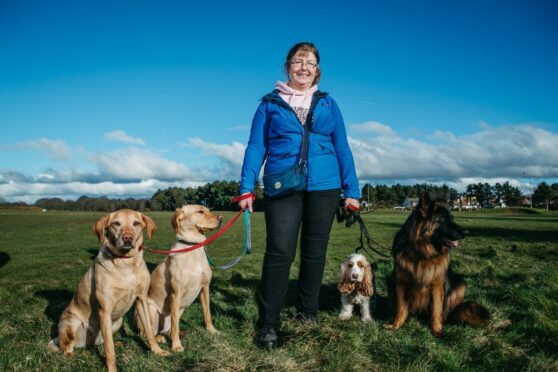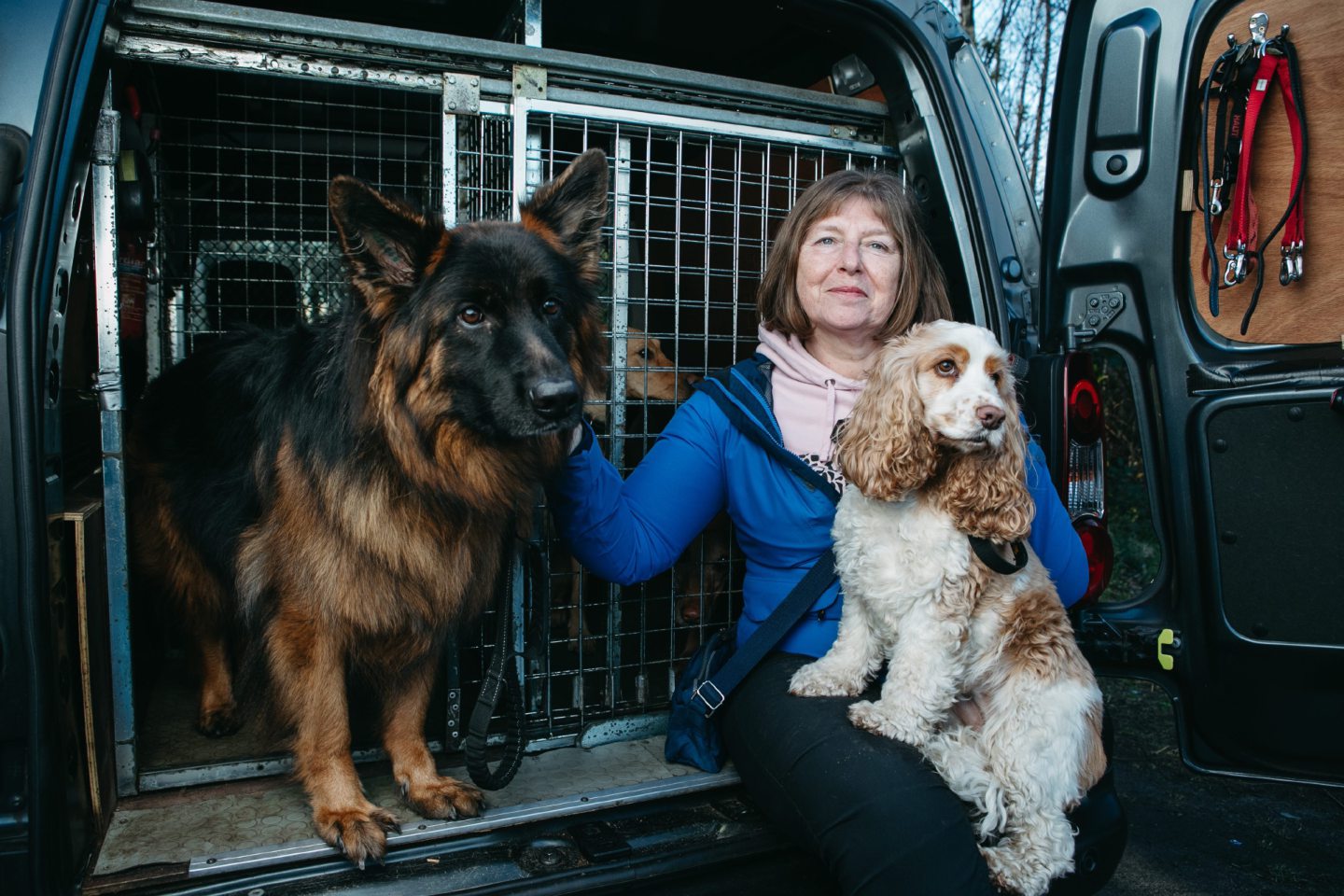
Lockdown almost did for Sandra Ferguson’s business but the end of lockdown has seen demand for her dog-walking service surge as pet owners return to work.
With an estimated 3.2 million households in the UK buying or adopting a pet since the start of the first lockdown, Ferguson says more returning and new customers are now seeking professional dog-walking services as they spend less time at home and more hours in the office.
She said: “From lockdown, my goodness, it’s a different scenario altogether. It has just gone bang. We currently have two vans that are out working all day, every day. We could put two more vans on the road tomorrow and they would be full. Demand is far outweighing the supply.”
Based in Troon, Ferguson has been running the aptly named Dog Tired Ayrshire alongside her husband, Mike, and son, Stuart, for the past 10 years and admits the increase in interest has been welcome, particularly as the pandemic devastated their business.
“Before lockdown we were in the fortunate position of running at capacity for our walking services,” explained Ferguson, who will celebrate a decade in business next month. “When lockdown happened, nobody really knew whether they were going to come out the other side – we didn’t know if the demand would still be there, or if our clients were even going to have jobs at the end of it. It was an abyss, a really worrying time.
“At the time, we had been running the business for eight years and it was our sole income as a family. We just didn’t know if there was going to be anything to take forward after lockdown. Plus, we absolutely missed the dogs.”
Walking 30 to 35 dogs a day, for 30 minutes up to an hour, the family also offer home visits, doggy daycare and overnight boarding. Ferguson says being a professional dog walker is a lot harder than most people think, especially as there is a lot of responsibility that comes with the job.
She explained with a laugh: “People do say to me all the time, ‘Oh I wish I had your job, putting a lead on a dog and going for a walk’. It’s really not as easy as that. It’s very specialised. You always have to be prepared, and keep your full attention on the dogs at all times. We are fully aware we are looking after a valuable part of the family.”
When out and about, the handlers only take four dogs each at a time and, although business is booming, Ferguson says they won’t be recruiting any time soon.
She added: “You’ve got to work up a really good bond with the dogs, and they have to work up one with you. It’s a two-way trust situation, especially for dogs you are walking off-lead. That is a process that just doesn’t happen overnight, and you need to give each dog the attention it deserves. For those reasons we don’t walk any more than four dogs per handler.
“You aren’t just walking and looking after someone’s prized possession. You are also responsible for the owner’s keys and home too. So, while expanding was something we discussed, we would rather keep it in the family.”
It’s not just professional dog walkers such as Ferguson who are seeing their business grow. Rikke Rosenlund, CEO and founder of BorrowMyDoggy, an online service that connects owners with local “borrowers”, says her website has seen rising interest from previous and new dog owners, as well as those looking for companionship without the commitment.
She said: “Coming out of the pandemic, we have at least doubled the amount of new dog owners on the site versus where we were a year ago.
“From the owners’ perspective, we have seen a big increase because people are going back to work, travelling more, going out to restaurants and the theatre again, and it makes more sense, rather than leaving your dog home alone, to have someone from across the street take care of them.
“On the other hand, there’s a lot of people who want to spend time with a dog but can’t have their own because of financial reasons, not necessarily having sufficient time, or they don’t have the space. So, they take care of other people’s dogs for the love of them.
“There is no money exchanged between the owner and the borrowers, so everyone is doing it for the love of dogs.”
Research by charity Guide Dogs, released this month, revealed 74% of dogs are showing signs of poor mental health, with 18% presenting symptoms as often as weekly. So, the return to the “before-Covid” life hasn’t just been tricky for owners to navigate but their dogs, too.
Dog behaviour consultant Jim Gillies has noticed a “massive surge in behaviour issues across the board” and says many worried owners have been reaching out for help. “The first was lockdown itself created an artificial environment for dogs during their critical period for development,” he said.
“For example, if somebody took a puppy during lockdown, the first three months of a puppy’s life are extremely important to their social development. During that time, they are learning about bonding and social communications with both people and dogs, as well as how to interact and respond to different environments. And, simply put, they’ve just not been exposed to a variety of individuals, objects, sights, sounds and smells.
“Now, as we’re coming out of the lockdown, what we’re seeing is massive overexposure and change of routine. We’re going back to what we would deem to be ‘normality’ but, from a dog’s perspective, it’s a radical change and that curve is causing real issues.”
The symptoms of a dog in distress, he says, may be things like whining, barking, pacing, hyper-vigilance, and being unsettled in the home.
He added: “During lockdown, owners were reporting an increase in their very healthy bond with a dog, which is lovely. Now, the difficulty is some dogs have become too reliant on their owner and guardian, who are going back to work. So, they haven’t been exposed to being away from their owner. Routine is important for dogs and that has also dramatically changed. So, this is triggering anxiety and stress.”
Ferguson, too, has seen similar issues with anxious and stressed pups: “We have noticed changes in some dogs since lockdown.
“They have been 24 hours a day, seven days a week with their owners, who weren’t going anywhere, and no one from outside was coming into the home. Separation anxiety has crept in for some dogs, so you have to work very carefully.”
Gillies, who also hosts a podcast called Barking From The Wooftops, advises the best thing to do is seek professional help. “Dogs live in captivity – we don’t see them in that way because they are our pets, but they do,” he said.
“They don’t have many choices in their life to express natural normal behaviour, so if we can build that into their daily routine, it can make them a bit more emotionally resilient. However, each individual dog is different and needs to be treated as such, so it’s all about gradual exposure.
“If owners are concerned in any way, they should bring in a behaviourist to create a structured plan to follow. It really will help.”

Enjoy the convenience of having The Sunday Post delivered as a digital ePaper straight to your smartphone, tablet or computer.
Subscribe for only £5.49 a month and enjoy all the benefits of the printed paper as a digital replica.
Subscribe © Andrew Cawley
© Andrew Cawley